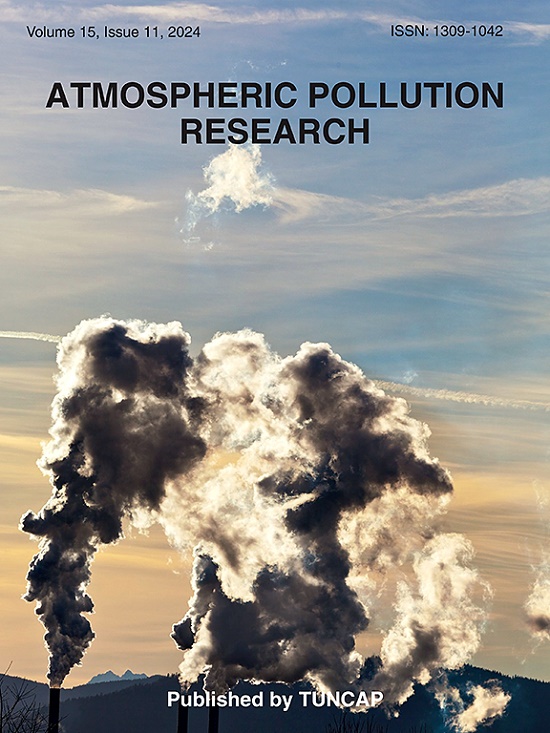Study on the NO2 pollution and its connection with PM2.5 and O3 in Dazhou based on source apportionment
IF 3.5
3区 环境科学与生态学
Q2 ENVIRONMENTAL SCIENCES
引用次数: 0
Abstract
Dazhou, as one of the key construction cities in the Sichuan-Chongqing economic belt, has experienced accelerated economic development, accompanied by a dense population, extensive infrastructure construction, and rapid industrial growth. Consequently, air pollution has become increasingly severe, with the mass concentration of NO2, a primary pollutant, being a significant constraint on air quality management in the city. This study utilizes the WRF-CMAQ (Weather Research and Forecasting Model-Community Multi-scale Air Quality) model to quantitatively analyze the main sector sources of NO2 in Dazhou during different seasons in 2022. The findings reveal that industrial sources contribute the most to NO2 pollution in spring and winter, while transportation sources dominate in autumn. Additionally, the correlation between PM2.5, O3, and NO2 concentrations, which exhibit significant seasonal variations, was examined. Notably, in summer, a negative correlation between O3 and NO2 concentrations was observed, while a positive correlation between PM2.5 and NO2 concentrations was evident in winter. Furthermore, the correlation between NO2, O3 and PM2.5 concentrations across different sectors was analyzed using ISAM (The Integrated Source Apportionment Method). In spring, the energy sources of NO2 and the transportation sources of O3 are significantly negatively correlated, with a correlation coefficient of −0.94. Additionally, the residential sources of NO2 are significantly positively correlated with the transportation sources of PM2.5, with a correlation coefficient of 0.96. In autumn, the energy sources of NO2 exhibit the most significant correlations with the industrial sources of O3 and the transportation sources of NO2 and PM2.5. In winter, the correlations among various sectors for O3 pollution are not significant, with correlation coefficients ranging from 0.02 to 0.63. The highest correlation is observed between the industrial sources of NO2 and the residential sources of PM2.5, reaching 0.98. This study analyzed the main source sectors of NO2 in Dazhou City and the correlation with the source sectors of O3 and PM2.5 by using the CMAQ-ISAM source apportionment method, revealing the importance of seasonal cooperation in air pollution control in Dazhou and emphasizing its significance for long-term pollution management.
基于源解析的达州市NO2污染及其与PM2.5、O3的关系研究
达州作为川渝经济带重点建设城市之一,经济发展加快,人口密集,基础设施建设广泛,工业增长迅速。因此,空气污染日益严重,NO2作为主要污染物的质量浓度已成为制约城市空气质量管理的重要因素。利用WRF-CMAQ(天气研究与预报模式-社区多尺度空气质量)模型,定量分析了2022年达州不同季节NO2的主要部门来源。结果表明:春、冬季工业源对NO2污染贡献最大,秋季交通源对NO2污染贡献最大;此外,还研究了PM2.5、O3和NO2浓度之间的相关性,它们表现出显著的季节变化。值得注意的是,夏季O3与NO2浓度呈负相关,冬季PM2.5与NO2浓度呈正相关。此外,利用ISAM (Integrated Source分摊法)分析了不同部门NO2、O3和PM2.5浓度之间的相关性。春季NO2能量源与O3输运源呈显著负相关,相关系数为- 0.94。住宅源NO2与交通源PM2.5呈显著正相关,相关系数为0.96。在秋季,NO2的能源来源与O3的工业来源、NO2的运输来源和PM2.5的相关性最为显著。冬季各部门间O3污染相关性不显著,相关系数在0.02 ~ 0.63之间。工业源NO2与居民源PM2.5的相关性最高,达到0.98。本研究采用CMAQ-ISAM源解析方法,分析了达州市NO2的主要源部门及其与O3和PM2.5源部门的相关性,揭示了季节合作在达州市大气污染治理中的重要性,强调了其对长期污染治理的意义。
本文章由计算机程序翻译,如有差异,请以英文原文为准。
求助全文
约1分钟内获得全文
求助全文
来源期刊

Atmospheric Pollution Research
ENVIRONMENTAL SCIENCES-
CiteScore
8.30
自引率
6.70%
发文量
256
审稿时长
36 days
期刊介绍:
Atmospheric Pollution Research (APR) is an international journal designed for the publication of articles on air pollution. Papers should present novel experimental results, theory and modeling of air pollution on local, regional, or global scales. Areas covered are research on inorganic, organic, and persistent organic air pollutants, air quality monitoring, air quality management, atmospheric dispersion and transport, air-surface (soil, water, and vegetation) exchange of pollutants, dry and wet deposition, indoor air quality, exposure assessment, health effects, satellite measurements, natural emissions, atmospheric chemistry, greenhouse gases, and effects on climate change.
 求助内容:
求助内容: 应助结果提醒方式:
应助结果提醒方式:


